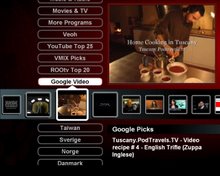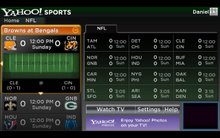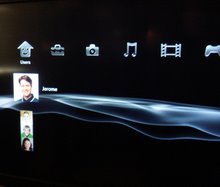Navigate YouTube available at iTunes App Sore
Browse video Standard Feeds, Categories, Channels and Playlists. Then organize new videos into your own favorites and playlists. Make playlists private or public. Subscribe to other user's playlists and video collections for future viewing. Subscribe to videos matching search-words.
Search for new videos tagged for your language or geographical region, using local keyboard. Explore for new videos via easy switching of user ID to the owner of interesting videos - then explore their world.
All actions are kept in sync with PC, Mac or Apple-TV access to YouTube. Available at Apple App Store.
active-TV technology for PC

Windows PC based home network
Wednesday, May 23, 2007
An alternative to "please use my portal"
The Issue: Ambitions strategies to secure a key or exclusive role in the delivery of internet video are still the game for many.
Background: Some experienced companies are seeing collaboration is the better way to reach an audience.
Behind the Scenes: Active-TV technology is the glue enabling collaboration between video distributors and living-room hardware (e.g. TV) developers.
A Wall Street Journal article states that several major TV industry companies are “betting that they can build their own Internet video portals”. However, CBS plans to revise its Innertube portal strategy, with the use of widespread syndication rather than a single portal. After a year experimenting with a portal approach, CBS has concluded “forcing consumers to come to one site -- its own -- to view video hasn't worked.”
Access to video portals is mostly accomplished with a PC using broadband service. The accompanying UI is typically formatted for PC usage, assuming a keyboard and mouse will drive the UI. Many portals are not accessed via the PC browser, but via a “player” (PC software built specifically for accessing the portal). In some cases, such as Yahoo Go for TV, UIs have been formatted for the TV; But since the approach requires a PC to be attached to the living room TV, there are few users.
CBS is reported to have “abandoned attempts to build its own blockbuster portal”, but it has signed deals with smaller video distribution companies like Veoh. This enables a path for CBS video to reach the living room TV, as Veoh as well as supporting PC-web formatting, has a TV-web formatted option.
I suggest the scramble to secure a significant role in the delivery of internet video to TVs around the home, has produced overly ambitions strategies. Different companies are hoping to have the one portal that matters or the one TV UI that everyone uses or the one TV advertising delivery mechanism that has the numbers. Maybe the MBAs in these companies are required to promote exclusive ideas in order to support their projection of business growth. But without a widely accepted rout to the TV in use, there is no clear yardstick to measure ambitions proposals.
Participation in the scramble is particularly difficult because most companies don’t build or market the necessary hardware needed to deliver video to the TV. Without this piece of the puzzle it is hard to control the outcome. This likely contributed to Apple introducing its Apple TV platform, enabling the user to access the Apple portal.
Most companies are not able to make the deals needed to extend their strategy to include delivery of video to a large number of TV or Set-Top Box (STB) in living rooms. If the manufacturer or supplier of a networked STB constrains its access to a preferred portal, it may not meet with user approval. Each TV viewer may want to exert his or her own choice. This conundrum adds an amount of irony to the scramble.
The introduction of networked STBs supporting the popular DVB-t transmission brings a solution to the European market. These STBs are bought at retail, and there is little business pressure to constrain them to a single portal. They are popular due to the uptake of free-to-air digital broadcast TV. Using active-TV technology with a DVB-t STB, the buyer is free to access any TV-web formatted channel. Technically speaking, a similar approach using free-to-air ATSC, or cablecard, and active-TV technology could be used in the US market. Such boxes are available from Avtrex and others, but US STB users expect the box to be provided by a cable TV service, and do not buy a STB in retail. This is why US reports often speak of the networked game console leading the uptake of internet video delivery to the living room TV.
Just as PC-web pages that are only accessible by one type of PC browser would meet will little web user approval, producing a TV-web channel which can only be viewed through a single player or unique hardware, will reach a reduced TV audience. This may ultimately determine the lesson to be learned by developers of video portals and eliminate the cry "please use my portal". The home user wants the freedom to select their internet video source and be assured it will always be viewable via the hardware and TV in their living room.
Active-TV technology provides TV-web with the same universal access and opportunity available to PC with PC-web. It is the glue for collaboration. It enables the video distributors to be confident their channel will operate with living room hardware. It provides the independent hardware developer with video to demonstrate their product in action.
Feedback, corrections and comments welcome. Contact me for more information or support with active-TV technology development.
Daniel Mann
Tuesday, May 22, 2007
crossing the divide
The Issue: Early growth of internet video delivery has concentrated on PC users, but this is expected to expand to include TV viewers.
Background: The networked game console and Apple TV-like boxes, will initially bridge the internet to the TV.
Behind the Scenes: Active-TV technology is used to support more than internet video streaming. It allows a TV UI to be delivered over the internet to the TV without adding significant complexity or cost to the TV-side hardware.
A report by ABI Research agrees with other observers that online video is currently viewed at the PC, but “the ultimate destination for much of this content will be the TV”. They estimate that $1.5B in service revenue will be generated from networked delivered video-to-TV by 2012.
An outline of the report indicates that they expect platforms form Apple, Netgear, Sony and the like, to “bridge” to the TV and “cross [the] divide” that separates the PC and TV. The networked game console is expected to lead the way for video delivery.
Currently, a reported 24% of video downloads to the PC are transferred to DVD and then watched on a TV via a DVD player or game console. The DVD-burn and walk-net process is completely eliminated with a networked game console or networked Set-Top Box.
The sale of over 100M Sony Playstation 2 game consoles, which for now continue to outsell the Xbox 360 and PS3, makes them a leading candidate for early adopters. There are estimates of about 10M PS2 already installed in US home networks – to support network gaming. Using active-TV technology software from BroadQ, the need to burn a DVD is eliminated. BroadQ's software is installed in the PS2 just like any game disk. But when running, the TV attached to the networked PS2 can access video, photos, music and more from any PC in the home network. Further, it can reach across a broadband connection to access TV-web channels.
In addition to the installed base, the low cost of the PS2 will pressure the Digital Media Adapter (DMA) alternatives, such as the Apple TV. Suppliers of networking technology may find a niche in the DMA segment by integrating their wireless networking technology. Ultimately, the TV will be network enabled with active-TV technology integrated directly into the TV. Certain TV OEM’s are currently working on such projects, which is expected to add further value to the TV and benefit the home user.
Feedback, corrections and comments welcome. Please Contact me for more information or support with active-TV technology development.
Daniel Mann
Friday, May 18, 2007
Demand for internet access at the TV
Active-TV Ecosystem Developers,
The Issue: PC users have experienced internet video, now they want it on the TV.
Background: The living room PC has limited acceptance, but networked TVs and networked STBs are emerging to accomplish the task.
Behind the Scenes: Active-TV technology and TV-web formatting solve the technical and cost constraints in enabling living room TV access to internet video.
In the New York Times article Internet Meets Large Screen, personal efforts to converge the internet and the TV are described. The biggest obstacle remains “finding the right hardware”. This refers to finding a living room appliance which does not have the cost, heat, noise and maintenance requirements of a PC connected to the TV; But allows viewing of internet delivered video. This problem is solved with networked TVs and networked Set-Top Boxes (STB) supporting active-TV technology.
The article goes on to say “the standard graphical desktop interface is hard for couch dwellers to use” – referring to PC-web pages not being suited to TV viewing. This is solved with TV-web formatting. TV-web is normally formatted with large fonts – if any text is required – and does not require a keyboard or mouse. Correct TV-web formatting eliminates the reported “constant challenge” of “juggling computer settings to make fonts readable”.
The benefits of Hewlett-Packard’s networked TV approach, MediaSmart TV, are described as enabling access to PC video “without bringing the pain of the PC into the living room”. However, MediaSmart TV like, Apple TV, do not support completely “open” access to TV-web formatted channels. Apple TV enables access to video from Apple’s web site or Apple portal.
Steve Perlman is quoted in reference to the emergence of a suitable TV-web format, “when that happens, you’ll see an utter transformation of the business”. Well it is starting, and active-TV technology is enabling TV-web to reach living room TVs via home networking. I don’t think at all that “broadcast stations will all turn off”. They will likely use the same technology to support and build audience interest in popular broadcast shows.
Feedback, corrections and comments welcome.
Daniel Mann
Wednesday, May 9, 2007
Adding a TV-web channel to a TV's channel list
The Issue: Can adding a TV-web channel to ‘TV favorites' be as easy as PC browsing ?
Background: TV-web channel developers are leveraging the naming and formatting conventions of Media Center and RSS syndication to ensure easy and consistent access to TV-web channels.
Behind the Scenes: A simple web-accessed button
Whereas it is easy to add a PC-web page to the list of favorite or frequently used web pages -- as simple as clicking on ‘Favorites --> Add to Favorites --> OK’ in your Internet browser -- how is a TV-web channel added to the list of channels viewable on the TV ?
There are several methods available; I will present one below.
TV-web channels have a URL just like PC-web pages, but they are identified by icons, not text strings. As an example, let’s look at the Honda TV channel built by Honda U.K. and their media agency, Zype. The Honda TV-web channel is accessed over the internet and formatted for viewing on an active-TV enabled and networked TV or STB. Honda has several uses for the technology. Below is a TV screen-capture of the Honda TV-web channel.
[Note that Honda TV is formatted for a 16x9 widescreen TV, and unlike some channels, does not automatically adjust for viewing on a 4x3 TV.]
The Honda TV channel allows home users to view 'Honda TV' on their TVs. Included in the channel line-up are short 20 minute documentaries about current Honda car models, including news updates from Auto shows, as well as behind-the-scenes stories and new car videos.
Aside from attracting consumers to check out the latest offerings from Honda, active-TV technology has sparked what is being called “Dealer TV”. In-showroom TV-web channels can present model and ownership information to those visiting the showroom. Moreover, Honda U.K. can use TV-web channels to simultaneously broadcast training videos and corporate messaging to its dealer network. This approach is likely suited to other retail settings besides Honda.
Active-TV technology has followed the rules for TV-web channel addressing first set-out by the Media Center PC. This makes it particularly easy for active-TV enabled TVs to view TV-web channels originally intended for Media Center supported platforms. A TV-web channel can be viewed on a living room TV via an Xbox360 operating as an Extender. At the TV, the channel listing will be included under the More Programs menu. To get the channel to appear under the TV menu, it must first appear in the networked Extended-PC’s file system at the location C:\Documents and Settings\All Users\Start Menu\Programs\Accessories\Media Center\Media Center Programs. [There are other methods which are not covered here]
Digging into the technical specifics for this example, the PC file entry for Honda TV is named Honda.mcl looks like this:
<>
href="http://www.smarthomedesign.co.uk/honda/honda_home.htm">http://www.smarthomedesign.co.uk/honda/honda_home.htm
name="Honda TV"
thumbnailImage="http://www.smarthomedesign.co.uk/honda/images/honda_call_to_action.jpg" >
< / application>
MCL stands for Media Center Link. The MCL files contains three important lines which identify the URL for the TV-web channel, the name of the channel and the URL for the thumbnail image or icon which appears in the TV menu. The image used by Honda TV is shown bellow:

To make things convenient a simple mechanism is needed for installing the necessary MCL file. Such conveniences exist for accessing an RSS video or music feed via Apple iTunes. PC-web pages with the button
Once a podcast has been added to the iTunes listings, the podcast can be accessed in a living room via a networked Apple TV. Similarly, a visitor to a Honda PC-web page, can select the
[The code used with the simple active-TV example above, has only been developed to support Windows XP platforms using Internet Explorer.]
Just one method for simply adding a TV-web channel to the channel listings has been described. The method is useful when a channel is discovered from an associated PC-web page. There are already mechanisms for adding a new TV-web channel which is discovered while watching an existing TV-web channel.
If you don't have a active-TV enabled TV or STB, but want to see how it looks on a TV, then download the evaluation software from active-TV technology collaborator MediaMall. They have put together a bundle of active-TV technology software which enables the PC to emulate the TV operation. The demo assumes a Windows XP or MCE PC, and no use of corporate domain networking. Navigation is via the left-right arrows and F12 is used for 'back'. The bundle uses their example menu system, but like PC-web pages, the appearance is easily changed or branded and other companies are also working on alternatives UIs and extensions.
Feedback, corrections and comments welcome.
Daniel Mann
Wednesday, May 2, 2007
Glasnost TV versus Closed Service TV
The Issue: Video entertainment upstarts plan on using internet distribution to reach an audience.
Background: Established video broadcasters unlikely to grant free access to the living room TV.
Behind the scene: active-TV technology is capable of granting video distribution to the highly-prized living room audience via a multi-purpose application of the familiar Set-Top Box.
A frequently reported digital convergence analysts, Rob Enderle, implied in a recent article that active-TV technology “is licensed to third parties” by AMD. In fact, AMD does not license any active-TV technology. More correctly, there are several companies offering active-TV technology components. A Set-Top Box (STB) or TV developer is able to select from a variety of suppliers, depending on the particular set of features they wish to enable. In short, there is no single supplier of active-TV technology.
Interestingly, Enderle goes on to say that active-TV technology is “far more complete than Apple TV” and also “AMD has less control over the finished product”. I agree. In fact, since AMD does not license any of the technology, it is difficult to see how it would have any control over other companies’ active-TV based product. Enderle’s statement about active-TV being “complete” likely refers to its neutrality and accessibility when delivering video to the TV.
Active-TV technology tries to bring the openness of the PC-web to TV-web channel viewing. This is described as “painfully complex making this offering more difficult to sell even though it may actually provide one of the better values”. As PC users know, accessing the familiar PC-web can be complex; there are few regulations and imposed standards or quality assurance, but it is open to everyone. Active-TV technology brings these same problems and benefits to TV-web viewing.
Active-TV technology has been described as a step towards glasnost TV via networked-delivered video. It is also a relatively inexpensive approach, as it utilizes an already familiar or available ecosystem of components. However, its openness does not bring any assurances of TV channel quality. In fact it is so open that anyone who can build a blog or a PC-web page can also build their own TV-web channel. The currently closed Apple TV approach is much more restrictive, but Apple can better control the quality of the accessible video materials.
The informed Enderle goes on to described active-TV technology “as the most opposite to Apple’s, harder to use and not as attractive or as well marketed but with massive amounts of content including over-the-air broadcast support and no lock-in to any one content provider or hardware company. Call it maximum flexibility with the possibility that one of the licensing vendors will create an ease-of-use experience and market it so that its technical advantages over Apple TV could result in stronger sales numbers.”
Barriers to reaching the TV
For a long time I have heard the question (particularly in the US), why should the established broadcasters open their network (or associated STBs) to channels from other sources. It is suggested that executives at established channel suppliers, or even the IP-TV start-ups led by MBAs, want control over the video and any associated advertising. They may allow TV-web channels to enrich the content they already offer, but glasnost TV only suits the end-user.
Active-TV technology can equally be applied to closed systems; where video and TV-web channels are only accessible from a service provider’s portal. This principle could equally be applied to PC-web access, but there is no history of filtering URLs to restrict PC-web access. There is a long history of technical and marketing barriers to video entertainment in the living room. Will the freedom of PC-web access finally come to the TV? Or, will the old closed-system rules continue to survive the introduction of active-TV technology and the streaming of internet video to the living room?
My answer is that PC users are going to get a taste for PC-web video from companies like: Vmix, Veoh, UGO, Joost, Brightcove, NarrowStep, Babelgum and many more. Once users have experienced the freedom and variety of unrestricted TV-web channels, it is going to be hard to keep them satisfied with service from only self-serving portals. Users are initially going to experience TV-web channels from low-cost active-TV enabled TVs, Set-Top Boxes and networked game platforms – such as the Sony Playstation 2 - all quite easily purchased in retail stores. There are sufficient numbers of companies who just want to make money from selling an attractive hardware platform. Using active-TV technology immediately makes these boxes increasingly attractive and solves the hardware developer’s problem of demonstrating access to interesting video material.
Other approaches
As to other approaches to bringing internet-based video to the home viewer, a recent NY Times article describes a new IP-TV Box, which uses peer-to-peer (P2P) sharing to deliver video more efficiently. The Vudu box does not support active-TV technology, and works with a video portal service. The expected box cost is close to that of the Apple TV. These systems are closed-service systems, but as Odyssey’s Donatiello quoted in the NY Times states “You have to get the content to the television.” A PC-in-the-living-room approach has been largely rejected by home users. Digital Media Adapter (DMA) alternatives, such as Vudu and Apple TV, have yet to gain widespread acceptance. But the important objective is to deliver video to the living room and as the NY Times states “Steve Jobs at least, understands that”. Closed system boxes do allow the user to view video on the TV, but only video from the box providers approved sources. They don’t allow for widespread competition among TV-web channel suppliers. They are also not typically not multi-function boxes, which leads to cost and consumer acceptance issues.
Beyond a PC audience
YouTube is the video sharing site most talked about. It is famous for its short-format video. Now there are other companies like Joost who seek to make their mark in the same space. A critical differentiator may be support for increasingly longer-format and higher quality video from professional or semi-professional creators. This will put increasing pressure to make the same video available at the TV and not just the PC. The leaders in this new space may be those who first gain user approval at the TV location. There is a need for an open approach which enables TV-web channel developers to compete for viewers at the TV location, without having to first be granted approval from established broadcast suppliers or their STB providers. Active-TV technology provides this significant step towards glastnost TV.
A recent Wired article states the Joost vision as “universal TV, running on a hybrid P2P platform”. They also plan to exploit PC-based P2P video transfer efficiencies; But this is just PC-web, since without access to living room hardware such as Apple TV or an active-TV STB, there is no reaching the TV. To their credit, the Joost founders have successfully applied Skype’s VOIP technology to open-up a difficult to penetrate phone service business. Wired states an old Silicon Valley saying: “don’t bet against the internet”. And anticipates the Joost (Skype) founders might retort with the following corollary, “don’t bet against the Vikings”. Active-TV technology, interestingly, has every bit as strong Viking roots as Joost.
Ecosystem technologies
There are other emerging technologies helping to connect the home PC with the internet and a networked-STB. Orb software enables internet video to be transferred via a PC to the living room TV. Interestingly, it could also be used to send video in the other direction, out from the STB, in very much a Sling box manor. As discussed on the web, this is useful technology; particularly when distributing videos to portable player devices or micro-browser platforms like the Wii. But the TV UI is built by the Orb software. This can enable TV access to YouTube video, but the limitation is that the TV UI is not provided from a remotely access TV-web URL. Orb recently announced support for an active-TV enabled networked STB from Scandinavian based STB developer, Futarque. The Orb software and TV UI are browser based. In the Futarque case, the Orb TV UI runs on the PC and active-TV technology delivers the TV UI to the networked STB location.
Also of interest is TVersity which is currently working on an active-TV formatted TV UI for video streams distributed via RSS feeds. Like, Orb technology, there is also support for video reformatting before sending-on from the PC to the TV. This useful technology allows a user to subscribe to a TV-web RSS feed. At the TV, the latest video supplied by the RSS feed appears in the TV-web channel listings. Again, this is useful technology when forwarding video to a cell phone or PSP, but it does not give complete control over the TV-web channel’s User Interface (UI), which is possible via a TV-web channel directly formatted for active-TV. An interesting combination of these technologies would be a networked accessed active-TV UI which is also continually updated from an RSS video feed.
A low-cost and glasnost solution
There is a struggle by large and small companies alike to gain a significant position in video delivery to the home over the internet. This is fueled by the widespread acceptance of broadband service and home networking. Cost, technical and marketing barriers and partisan interests have focused current efforts on video sharing at the PC via PC-web. Active-TV technology is ideal for now moving the struggle to the living room TV location, or to any TV in the house.
Feedback, corrections and comments welcome.
Daniel Mann









